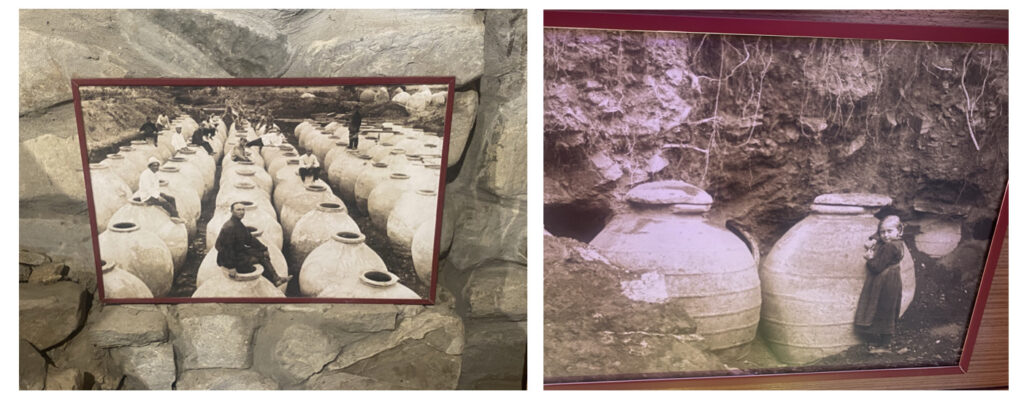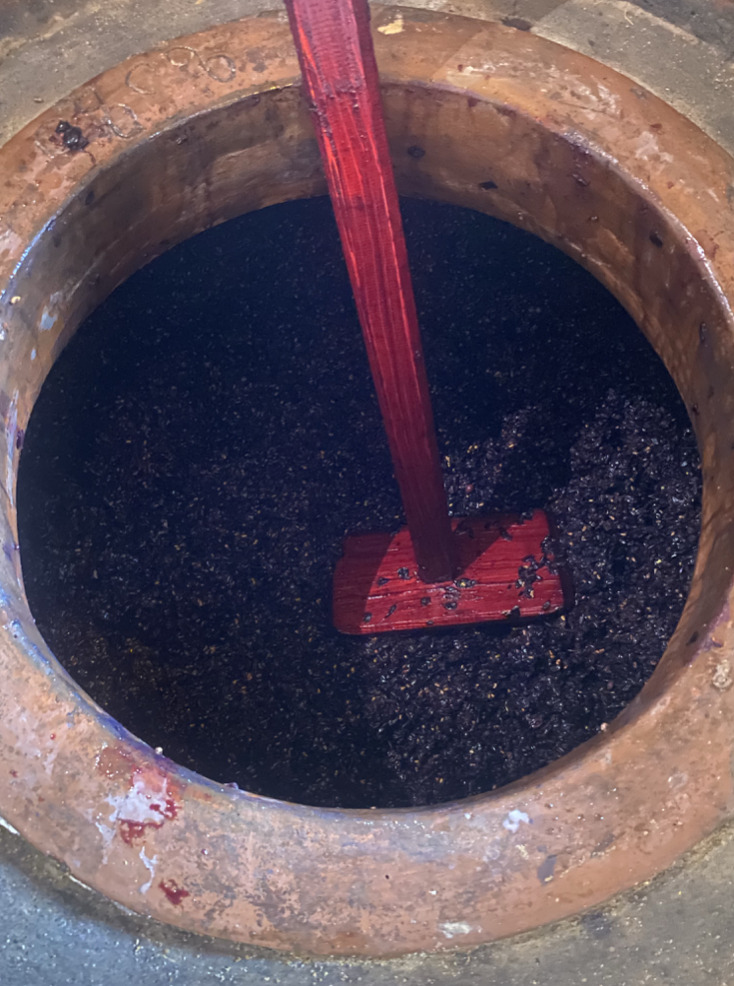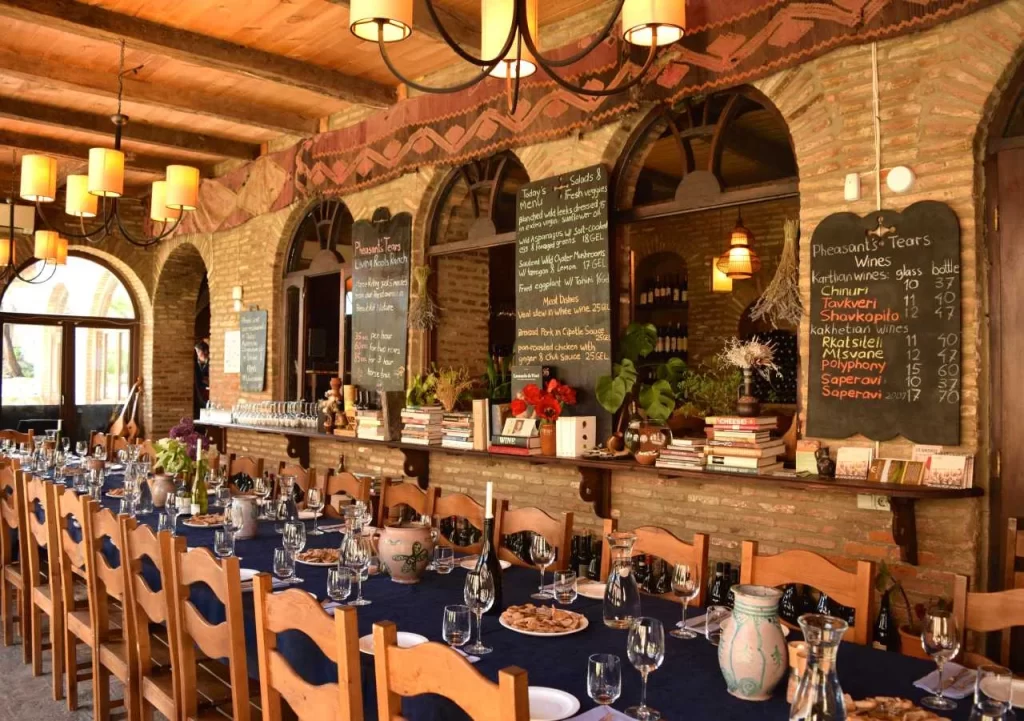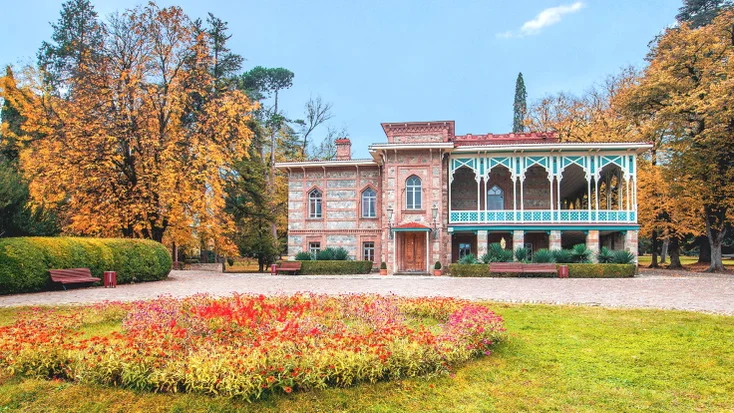Have you ever considered the grape pip? And its significance in history? Well, that little pip is incredibly important to the country of Georgia. Because it is the discovery of cultivated grape pips that prove that Georgian wine has been made for 8,000 years — making it what we consider the world’s first known wine-producing country.
These pips prove that people were intentionally selecting wild grape varieties for their winemaking potential and cultivating them for that purpose. Add the winemaking artefacts from the IV century and the puzzle pieces come together to paint the fascinating, and impressively long history of winemaking in Georgia.
During that period, Georgia made a prolific selection of grape varieties, which resulted in some 525 native grape varieties. Considering there are around 10,000 wine grape varieties in the world, that’s a rather impressive legacy.
The other legacy that emerged from this period was fascinating history of qvevri. Qvevri is the Georgian equivalent of an amphora, a large clay vessel in which wine is fermented and matured. Clay pots were prolific around the early ancient world of wine, but what gives it the Georgian twist is that these qvevri were buried — or planted — in the earth. This is a smart move for temperature control, as the wines have a much more stable and cooler temperature than above ground.
The tradition within Georgian wine was also for skin contact wines, leaving both white and red grapes in contact with the skins for the winter months — resulting in amber and red wines with strong structure and a very stable nature. (Interestingly the six months of skin contact over winter is still the standard today). Fragments of qvevri also date back to around 6000 BCE, found in the same site as the grape pips.

Old photographs of qvevri wines in Georgia
The stinger in the story though is that Georgia lost touch with that heritage during the Soviet era, in which the wine industry was rapidly and brutally industrialised. Genetic diversity was wiped out of the vineyards, and they were replanted with a more homogenous spread of just a few varieties — mostly Rkatsiteli and Saperavi.
Winemaking too was homogenised. At its peak Georgia had over 150,000 hectares of vineyards planted, but most of it — in fact, almost all of it — was bulk wine made in a semi sweet style, a recipe prescribed and managed by the state.
Since the collapse of the Soviet Union in the early 1990s, the industry has been in a period of transformation. For some years that followed, it continued to appease the sweet, simple tastes demanded by the Russian market, but in 2006 a Russian ban on wine imports from Georgia catalysed a change — Georgia started making wine for Georgia again.
Re-writing the modern Georgian wine culture
Since then, the country’s winemakers have been grafting hard to get Georgia back on its feet in terms of premium production and reconnecting with its past diversity and heritage. Since around 2008, many small wineries have been seeking to revive the plethora of indigenous varieties. This has spurred new vineyard plantations — growing from 45,000 hectares planted in 2004 to some 55,000 hectares today.
Of the 525 indigenous grape varieties of Georgia, around 30 of them are in production today. However, 437 of them are kept in conservation in collections, which potentially hints at a far greater future for Georgia’s diversity to come.
It was exploring these different grape varieties that most excited me on my recent trip to Georgia. Some of my favourite wines came from the rarer grape varieties. Mtsvani Kakhuri, for example, was lost for 80 years but the rediscovery since 2006 has been rather exciting. The wines show excellent potential in amber wines in particular, often with a combination of notes of sage, dried mango and other tropical fruits. It’s a really distinctive and unique variety in its expression, quite unlike anything I have ever tasted.
I also really enjoyed amber wines made from Khikhvi, Kisi and Tsolikouri, each offering a different nuance and character. Rkatsiteli is by far the most-planted white grape in Georgia (accounting for 35% of plantings in the country), and so perhaps it is no surprise that it was also the most varied in terms of quality and styles. I have found the risk with amber wines is over-extraction and bitterness of tannins, which some Rkatsiteli wines fell victim to, while the best walked that fine line of notable tannins wrapped in flesh and freshness.

Saperavi in qvevri on its skins
Meanwhile, in the red Georgian wines, Saperavi is the most-planted (31% of plantings). Saperavi can pack quite a punch when it comes to ripe fruit notes, and my favourite interpretations were those wines that avoided overripeness and were made with no oak influence. Although there are plenty of jammy, oaked styles of Saperavi, I believe that Georgians themselves hit the nail on the head with ageing Saperavi in qvevri. The qvevri (or concrete) highlights the more interesting savoury character that the wine can have, lending it a little more grip too.
Of the other native red varieties, there is definitely some exciting things happening — most especially as they can offer a lighter counterpart to Saperavi. I found Grubela very interesting, with an almost etherial quality and inviting earthy undertones, as well as Alaksandrolui, with its supple texture and freshness.
It’s clear that Georgia is still very much writing its new chapter in its wine history, but the buzz around this re-emerging wine country is well founded. Most of all, it was motivating to see so much pride in their own native varieties and traditional winemaking practices.
Interestingly enough, many locals still distinguish between what they call ‘factory wine’ and ‘local wine’. Anything made in qvevri is considered local wine, while larger production in modern stainless steel is considered factory wine. It’s an important distinction (although both exist in large quantities) that really shows the Georgian pride of reviving their own heritage and ancient wine culture. So much so, that in fact Georgia’s qvevri-makers are booked up years in advance with pre-orders. The demand is that high. I have no doubt too that these are the wines that will enable Georgia to increasingly stand out on the international stage.
It seems that Georgia’s star is, indeed, on the rise. Georgia’s journey back to the future must be one of the most exciting in wine today.
Georgian wineries to visit and look for
Dakishivili Family Vineyards
Gogi is a third generation winemaker whose family continued to make their own wine throughout the Soviet era, making him one of the rare winemakers with a continuous lineage. He was one of the first winemakers in Georgia to take qvevri wines to the trade, with his 2002 vintage, kickstarting the revived interest in the ancient traditions of qvevri wines, in particular on the restaurant scene. His wines today are very precise and quite elegant expressions, with the qvevri wines being a particular highlight but he also has some fabulously fresh pet nat wines too.
Open for visits
Twins Wine House
 The Gamtkitsulashvili family were another family which never stopped making their own wines, and in 1997 twins Gia and Gela decided to found their own modern winery to concentrated on making qvevri wines. Today they have an impressive 135 qvevris of their own! The focus has always been on looking back at the historical books and decoding what was done historically, which is how they came to create an excellent qvevri wine museum in 2013. The wines are qvevri-focused and the amber wines, in particular, offer excellent value for balanced, elegant wines yet with plenty of personality. Well worth hunting down. They also have a small hotel on the winery.
The Gamtkitsulashvili family were another family which never stopped making their own wines, and in 1997 twins Gia and Gela decided to found their own modern winery to concentrated on making qvevri wines. Today they have an impressive 135 qvevris of their own! The focus has always been on looking back at the historical books and decoding what was done historically, which is how they came to create an excellent qvevri wine museum in 2013. The wines are qvevri-focused and the amber wines, in particular, offer excellent value for balanced, elegant wines yet with plenty of personality. Well worth hunting down. They also have a small hotel on the winery.
Open for visits
Qvevri Wine Cellar
Natural wine producer Ivane Nareklishvili has a long history making wine for other wineries in Georgia and Italy, but in 2015 he started his own label — Qvevri Wine Cellar. This is a real gem to discover in Georgia and definitely some of the best wines I tasted there. His niche portfolio is all of low intervention wines, all made in qvevri, which show such finesse and elegance while also great character with fine, chalky tannins. Each of the amber wines is well worth trying, but so too is the juicy and vibrant pink Rkatsiteli (a mutation of white Rkatsiteli) and the floral, fragranced red Saperavi.
Not (yet!) open for visits
https://www.qvevriwinecellar.com/
Pheasants Tears
If you’ve heard of Georgian wine, you’ll likely have heard of Pheasants Tears. Now with a cult wine status, Pheasants Tears and founder John Wurdeman is one of Georgia’s best known producers of amber and qvevri wines, as well as some vibrant, juicy and bright red wines, too. A visit here is a delight, in the stunning town of Sighnahghi, where the family’s beautiful house (adorned with John’s artwork) is open for wine tastings and one of the best lunches I’ve had in Georgia. Delicious, unmissable.
Open for visits and lunch
https://www.pheasantstears.com/

Pheasants Tears restaurant
Marani Ruispiri
Passionate biodynamic winemaker Georgi is the consultant for a handful of biodynamic wineries around Georgia but also has his own small rather delicious qvevri wine portfolio. With rare grapes like Grubela and Khikhvi, as well as more classic native grapes such as Rkatsiteli, the wines are sometimes rather wild but always very characterful and fresh.
Open for visits
Koncho & Co
If you want to get a flavour of what Soviet-era production looks like, head to Koncho & Co. This mammoth Georgian wine producer, which kept its presses rolling as a Soviet wine production centre in the interim, churns out a lot of wine and a walk around shows you just how big production was in this period. But they also produce a smaller line of premium wines worth tasting, including an enjoyable amber wine from 75-year-old vines of Rkatsiteli and a delightful red wine of qvevri-aged Alaksandrolui.
Open for visits
Teliani Valley
Teliani Valley is a brand worth looking for, for its bright, easy-drinking wines made in an approachable way which act as a great introduction to qvevri and contemporary Georgian wines. It is a larger winery and offers a good spread of different regions and grape varieties.
Not open for visits
https://www.instagram.com/telianivalley/
Georgian wineries with hotels
Giuaani
This beautiful family winery right in the heart of the Manavi PDO specialises in Mtsavani, making it in a range of styles from young or oak-aged, to skin contact wines in qvevri, sparkling pet nat or even brandy! The Mtsavani qvevri wine is particularly exciting with age, developing notes of dried mango and lemon curd, as is the classic Manavi — especially if you get the chance to buy an older vintage. They also make a smashing Tsolikouri from Tvishi with good tension and grip from just 5% skin contact. All of these wines are well worth trying, and you can book a room in the boutique hotel, right there in the vineyards, and chill out by the pool with your glass of Mtsavani.
https://www.instagram.com/giuaaniwinery/
Chateau Buera
This is quite an impressive enterprise, with the young generation of the Maisuradze family now leading in running the stunning 200-room winery hotel resort and spa, five restaurants and a state-of-the-art winery. They make a combination of traditional qvevri wines and contemporary wines too.
Tsinandali Wine Estate

Tsinandale Wine Estate
This stunning wine estate is home to the fantastic Radisson hotel and spa resort, but also makes a smart set of biodynamic wines from the very first PDO of Georgia — Tsinandali. I particularly enjoyed their white blends, as well as the qvevri amber wines, and there’s a very good restaurant within the hotel.
Mtevino
This relatively large producer in the windy and warm region of Khasmi is known for its top Saperavi, which can be rich and velvety. The winery also has a boutique hotel with nice views across the valley.

